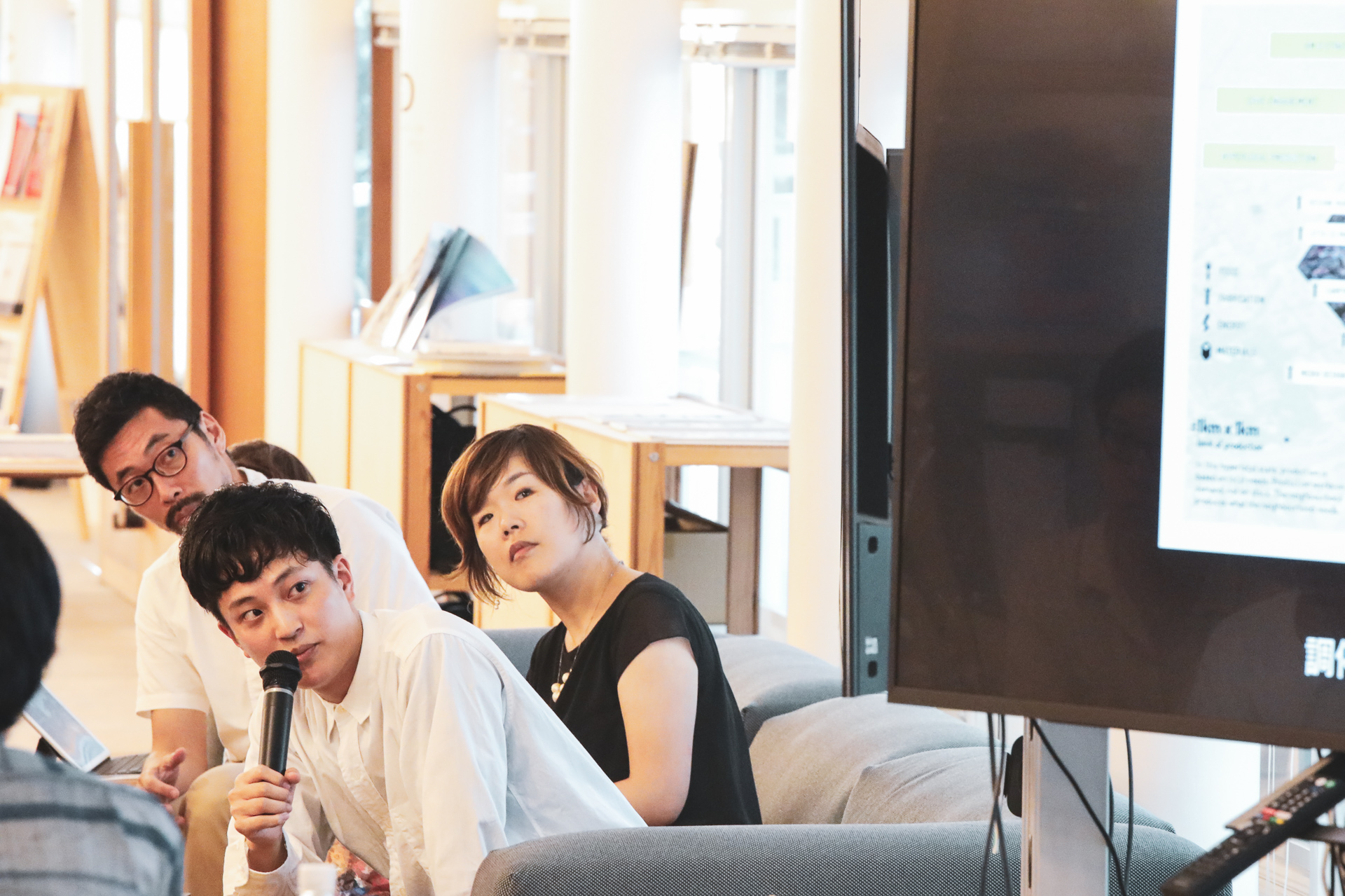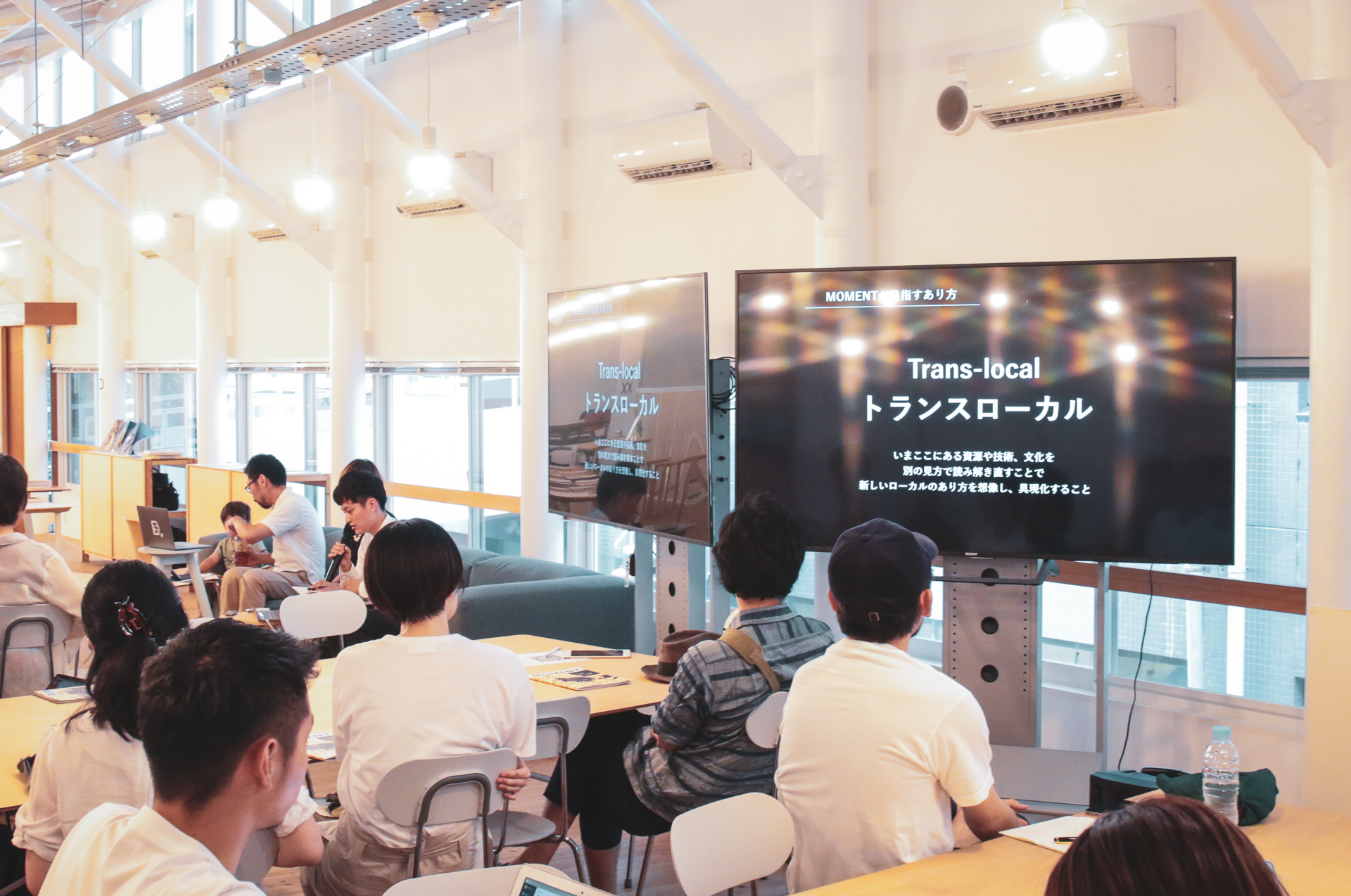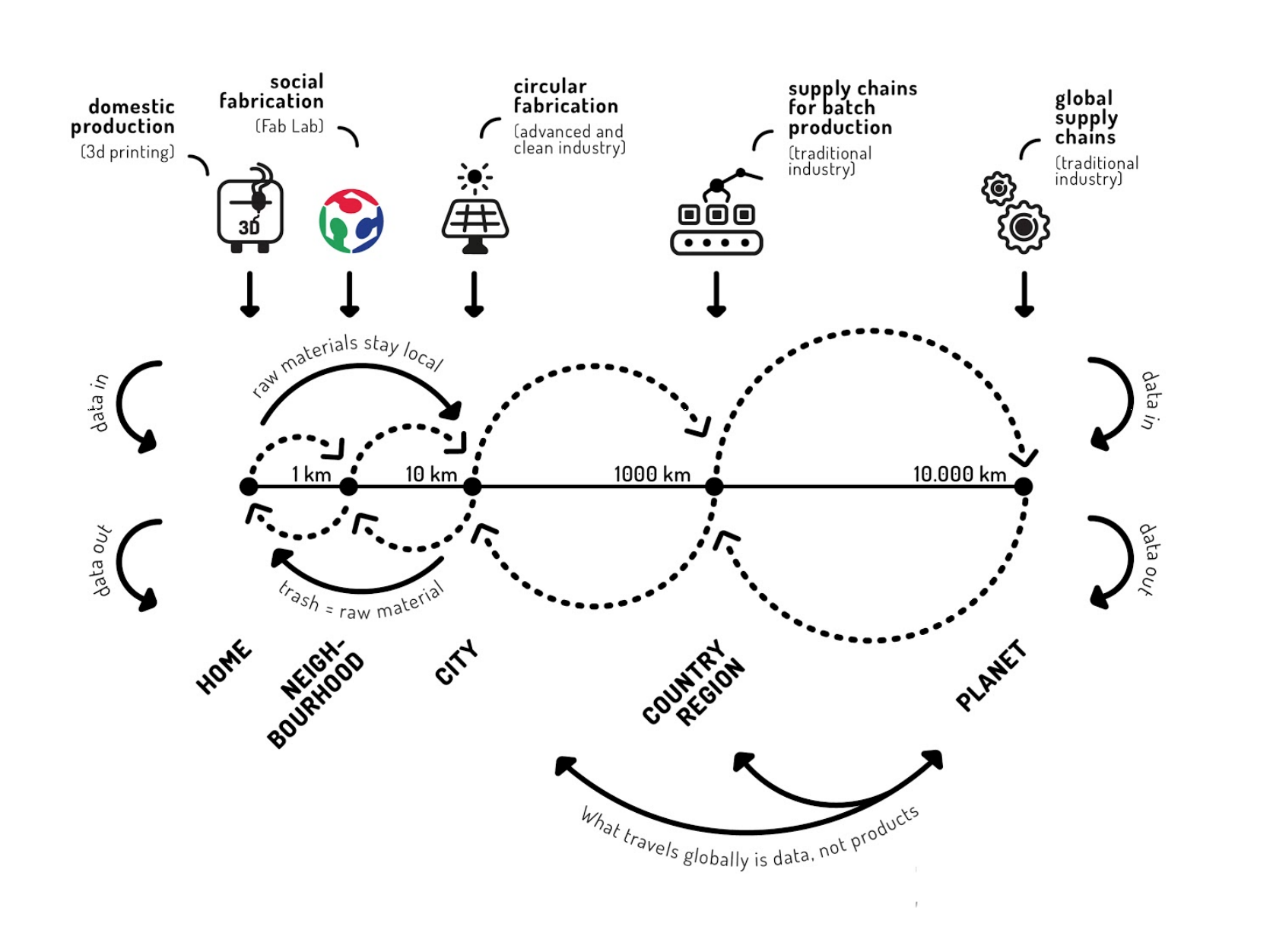水野大二郎特任教授とMOMENT編集部による「サーキュラーソサエティの現在地」と称したミニシンポジウムが、京都工芸繊維大学KYOTO Design Labで開催された。
建築史を専門とするグレゲリー・ペーター・パルナによるレポートをお届けする。
───
環境問題や移民問題などに代表される現代社会の課題は、都市や文化を超えて複雑に絡み合いながら進行している。さまざまな課題を抱える私たちには、現代都市で生活を営む知恵が必要とされているだろう。それでは将来の可能性を探るために、私たちは文化的、技術的、物質的資源をどのように使いこなすことが可能だろうか。2019年6月にリ・パブリックから発行された雑誌 「MOMENT」は、まさにこのテーマを扱っている。
KYOTO Design Labでは、これらのテーマをオープンに議論する場として、2019年7月30日に「サーキュラーソサエティの現在地」と題したミニシンポジウムを開催した。MOMENTの編集をおこなう内田友紀氏ならびに白井瞭編集長に加え、水野大二郎特任教授を交えて議論が展開された。

左から水野特任教授、白井氏、内田氏
SDGs(持続可能な開発目標)が世界中で多くの人々の注目を集める中、サーキュラー・ソサエティ(循環型社会)は、ユーザ中心のデザイン思考が過去数十年で行われてきたように、次の「究極のアプローチ」になりつつあるようだ。水野特任教授は、ヨーロッパに強いルーツを持つ多くの大学が、 「未来」と「素材」をキーワードにしたコースを提供しており、消費者のニーズに基づいたデザイン戦略をより幅広い社会環境的文脈に置き換える方法が研究されていると紹介した。その中には、ロンドン芸術大学、香港工科大学、アールト大学、カタルーニャ先進建築大学院大学などの学際的な試みがある。
この学術研究は、Fablabの分散型オープンソースやデジタルファブリケーション運動と強く結びついており、さらにスペインのバルセロナや日本の鎌倉が先駆的に実践するファブシティの分散ネットワークモデルにも拡張されている。白井氏と内田氏からは、MOMENTの創刊号では、こうした活動を成功事例として紹介するのではなく、彼らがトランスローカル(trans-local)と名付けた「異なる分野や慣習の越境性」を踏まえて、将来の都市のパラダイムを概観することを目的としていることが紹介された。

彼らがMOMENTに掲載する事例は、「-able City/エイブルシティ」というタイトルで特集している。しかしながら、都市が直線的に成長過程にあった時代のように、アナログ/デジタル、ローカル/グローバル、ボトムアップ/トップダウンまたはプライベート/パブリックという二項対立を解消するだけでは、成熟した現在の都市にトランス可能性が得られるわけではない。特に移民、地球温暖化、または環境汚染のような複雑な地球規模の問題を扱うときには、地域社会の閉鎖的なループが実際に循環することができるかどうか、そしてこれらが孤立した理論的実験の範囲を超えることができるかどうかを留意しなければならないからだ。
同時に、単に消費者のニーズに基づいた開発と社内ヒエラルキーに基づいた意思決定環境から逃れようとしなければ、経済的な潮流や社会のトレンドから抜け出すことは難しいだろう。そのため、複雑な社会課題から重要な要素をいくつか抽出することこそが、デザイン戦略において重要となるのだ。これは経営に直接的に有益な解決策に限られるわけではないため、異なる観点から科学的に分析する体系的な批評行為の教育が求められる。今日ではその役割の中心は大学や研究機関が担っているが、リ・パブリックなどのThink & do tank(シンク・アンド・ドゥタンク)として存在する私企業も同様に、さまざまな分野での社会的交流や学際的な連携を促進する上で大きな役割を果たしているだろう。
これらの取り組みを通じて、短期的に利益のみを重視するという近視眼的な資本主義経済的な考え方を変え、我々の社会を協創的な民主的構造に転換する機会がある。その好例が、何世代にもわたって家柄を持つことが多い、日本独自に発展を遂げた職人組織だと私は考えている。これは京都の伝統的な繊維産業の分業構造に見られる。まず原糸を準備し、それを撚って束ね、染色し、紡いで糸巻きし、紡織するというように、その生産工程が細かく段階的に分割されており、すべての段階がすべて異なる場所でおこなわれている。これはファブシティが提示される都市構造と酷似しており、このような文化的基盤に基づく様々な分野の間の壁の曖昧さは、まさに私たちが現代社会で達成しなければならないものである。彼らは伝統的に長期的な視点で事業を捉え、個人と企業を相互利益のために混合し、同時に避けられない文化的価値を伝えていることを重要視している。このように様々な分野の垣根を文化的に曖昧に拡張していくことこそが、現代社会に求められていることだと私は信じている。
─
─
─
グレゲリー・ペーター・バルナ(工学博士)
ブダペスト出身。ドイツの楽器アーティストであるマンフレッド・ブレファートや、ハンガリーでは工業デザイナーのフェレンツ・コラーと仕事をした後、2010年から京都に移り、京都工芸繊維大学で伝統的な木造軸組構法を学び、卒業後、宮大工として奈良県の重要文化財である称念寺の保存に従事した。2018年、同大学大学院で博士号を取得し、 (株) ネオマテリアでデジタル製造のデザイン研究に従事している。
Gergely Péter Barna (Dr.Eng.), Design Development Researcher, Neomateria Co. Ltd.
How should we live in modern cities? How could cultural, technological and material resources be used to support our future possibilities? These are the themes addressed in Moment, the trans-local magazine released by Re:Public Inc. in June 2019.
To start an open discussion on these topics, KYOTO Design Lab organized a mini symposium titled “The present state of circular society” on the 30th July 2019 having Prof. Daijiro Mizuno from KYOTO Design Lab, Ryo Shirai editor in chief of the magazine and Yuki Uchida managing director of Re:Public Inc. as the keynote speakers.

From left: Prof. Daijiro Mizuno, Ryo Shirai and Yuki Uchida
With the SDGs receiving more-and-more public attention globally, circular society seems to be becoming the next ‘ultimate approach’, just like the user centred design thinking has been in the last decades. As Prof. Mizuno described, numerous universities, especially in Europe, offer courses with the keywords ‘future’ and ‘material’, researching how the by default consumer need based design strategies could be replaced with a broader socio-environmental context. Among these are the University of the Arts of London (GB), Hong Kong Polytechnic University (CN), Aalto University (FI) and the Institute for Advanced Architecture of Catalonia (PT).
This academic work related to circular society also has strong bonds with the decentralized open source digital fabrication movement of the FABLABs, further extended to the distributed network model of FAB cities, such as Barcelona in Spain, or Kamakura pioneering in Japan. Introduced by Mr. Shirai and Mrs. Ucida, the recent issue of Moment features several examples of these under the title ( )able city, aiming not to promote these as success stories, but to outline the paradigm of future cities under the theme what they call ‘trans-local’, crossing over different scientific fields and conventions.

It has to be noticed however, that although these initiations are promising to release the conventional contradiction between analogue/digital, local/global, bottom-up/top-down or private/public, the question remains, whether the closed loop of a local community can actually become circular, and whether these can exceed the scope of isolated, theoretical experiments, especially, when dealing with complex global issues, such as migration, global warming, or environmental pollution.
At the same time, without attempts of escaping from the merely service and consumer need focused design and the hierarchy based decision making environment, it is hard to find the way out of the present trends in economy and society. The implementation of strategic design might be essential looking at various issues in their complexity, not limiting the solutions to the financially beneficial ones. This leads to the necessity of ‘designing culture’ consciously, for which the education of a systematic critical attitude analysing different aspects in a scientific way is crucial. Universities and academic institutions are the central scenes for this work, but think tank companies, such as Re:Public also have a great role in facilitating social interactions and the multidisciplinary collaboration of various fields.
Through these initiatives, there is a chance to change the general attitude of focusing mainly on the short term benefits, and transform our society into a collective, collaborative democratic structure. In my opinion, a great example for this can observed in the network of Japanese craftsmen, who, often having a family background of several generations, traditionally think in a long-term business perspective, mixing personal with corporate for the mutual good, while also transmitting inevitable cultural values. I can see this quite clear in the ‘bungyo’ (divised labour) structure of the traditional textile industry around where I live in Nishijin, Kyoto. Here, the production workflow has been split up to minute phases, having one household just preparing the raw yarn later to be roved, bundled, dyed, spinned to bobbins, and finally woven all at different places. Greatly resembling the structure of FAB cities, I believe, that this kind of blurring walls between various fields on a cultural basis is exactly what we have to achieve in our modern society.
─
─
─
Gergely’s Profile
Gergely Péter Barna (Dr.Eng.) was born in Budapest. After working with music instrument artist Manfred Bleffert in Germany, and industrial designer Ferenc Koller in Hungary, he moved to Kyoto in 2010 to study traditional woodcraft. While working as a carpenter on the restoration site of Shonenji temple (Important Cultural Property, Nara Prefecture), he finished his Doctoral degree in Design Science at the Kyoto Institute of technology. From 2018 he is working as a design researcher in digital manufacturing at Neomateria Co. Ltd..
